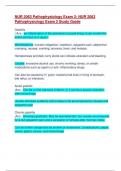NUR 2063 Pathophysiology Exam 2: NUR 2063
Pathophysiology Exam 2 Study Guide
Gastritis
(Ans - an inflammation of the stomachs mucosal lining. It can involve the
entire stomach or a region.
Manifestations: Include indigestion, heartburn, epigastric pain, abdominal
cramping, nausea, vomiting, anorexia, fever, and malaise.
Hematemesis and dark, tarry stools can indicate ulceration and bleeding.
Causes: excessive alcohol use, chronic vomiting, stress, or certain
medications such as aspirin or anti- inflammatory drugs.
Can also be caused by H. pylori- bacteria that lives in lining of stomach,
bile reflux, or infections.
Acute gastritis
(Ans - Can be a mild, transient irritation, or it can be a severe ulceration
with hemorrhage
Usually develops suddenly and is likely to be accompanied by nausea and
epigastric pain
Chronic gastritis
(Ans - Develops gradually. May be asymptomatic, but usually accompanied
by a dull epigastric pain and a sensation of fullness after minimal intake.
Can be further categorized as erosive or nonerosive. Complications: peptic
ulcers, gastric cancer, and hemorrhage
,gastritis Treatment
(Ans - Acute is often self-limiting and resolves within 3 days. Treatment
strategies for acute vary depending on the underlying etiology (e.g.,
antibiotics).
Treatment strategies for chronic include etiology-specific interventions,
antacids, acid-reducing agents, and mucosal barrier agents.
Gastroenteritis
(Ans - Inflammation of the stomach and intestines, usually because of an
infection or allergic reaction
GERD
(Ans - gastroesophageal reflux disease- where chyme periodically backs
up from the stomach into the esophagus.
Causes: are certain foods like chocolate, caffeine, carbonated bevs, citrus
fruit, tomatoes, spicy or fatty foods, peppermint, alcohol, nicotine, obesity,
pregnancy, and certain medications.
Complications: overtime the reflux of stomach acid damages the tissue
lining of the esophagus and can lead to permanent damage of it and even
cancer.
PUD, Peptic ulcer disease
(Ans - lesions affecting the lining of the stomach or duodenum.
Vary in severity from superficial erosions to complete penetration through
the GI tract wall Develops because of an imbalance between destructive
forces and protective mechanisms
Manifestations: epigastric or abdominal pain, abdominal cramping,
heartburn, indigestion, nausea, and vomiting
,Duodenal ulcers
(Ans –
• Most commonly associated with excessive acid or H. pylori infections
• Typically present with epigastric pain that is relieved in the presence of
food
Gastric ulcers
(Ans –
• Less frequent but more deadly.
• Typically associated with malignancy and nonsteroidal anti-inflammatory
drugs.
• Pain typically worsens with eating.
Stress ulcers
(Ans –
• Develop because of a major physiological stressor on the body due to
local tissue ischemia, tissue acidosis, bile salts entering the stomach, and
decreased GI motility.
Curling's ulcers
(Ans - stress ulcers associated with burns
Cushing's ulcers
(Ans - stress ulcers associated with head injuries
H. pylori
(Ans - PUD is most commonly caused by h. Pylori infection or due to
NSAIDS use. If left untreated it can turn into PUD
pseudomembranous colitis C. Diff
(Ans - swelling or inflammation of the large intestine (colon) due to an
overgrowth of Clostridioides difficile (C difficile) bacteria. This infection is a
common cause of diarrhea after antibiotic use. also called antibiotic-
associated colitis or C. difficile colitis
Signs and symptoms- watery diarrhea, abdominal cramps, fever, nausea,
, It is treated with antibiotics that target the infection.
Appendicitis
(Ans - is inflammation of the vermiform appendix
caused by infection
Symptoms are pain near right quadrant of the abdomen, nausea, vomiting,
fever, chills, abdominal distention, and bowel pattern changes.
• Sharp abdominal pain develops, gradually intensifies (over about 12-24
hours), and becomes localized to the lower right quadrant of the abdomen
(McBurney point).
• Complications: abscesses, peritonitis, gangrene, and death.
• Treatment
• Surgery, either laparoscopic or open, and may include extensive
irrigation.
• Drainage tubes.
• Long-term antibiotic therapy.
• Analgesics.
• Avoid activities that increase intra-abdominal pressure (e.g., straining and
coughing).
Diverticular Disease
(Ans - development of diverticula, outwardly bulging pouches of the
intestinal wall that occur when mucosa sections or large intestine
submucosa layers herniate through a weakened muscular layer. The
muscular wall can become weakened from the prolonged effort of moving
hard stools.
• Manifestations: abdominal cramping followed by passing a large quantity
of frank blood, low-grade fever, abdominal tenderness (usually left lower




